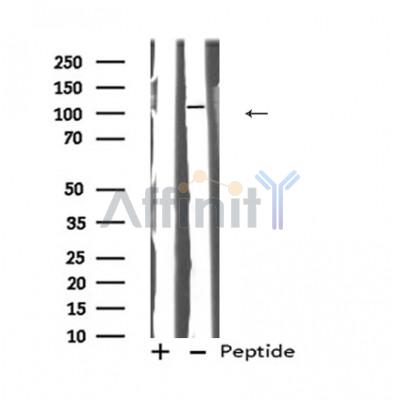HYOU1 Antibody - #DF8329
| Product: | HYOU1 Antibody |
| Catalog: | DF8329 |
| Description: | Rabbit polyclonal antibody to HYOU1 |
| Application: | WB IF/ICC |
| Reactivity: | Human, Monkey |
| Prediction: | Pig, Bovine, Horse, Sheep, Rabbit, Dog |
| Mol.Wt.: | 111 kDa; 111kD(Calculated). |
| Uniprot: | Q9Y4L1 |
| RRID: | AB_2841601 |
Related Downloads
Protocols
Product Info
*The optimal dilutions should be determined by the end user. For optimal experimental results, antibody reuse is not recommended.
*Tips:
WB: For western blot detection of denatured protein samples. IHC: For immunohistochemical detection of paraffin sections (IHC-p) or frozen sections (IHC-f) of tissue samples. IF/ICC: For immunofluorescence detection of cell samples. ELISA(peptide): For ELISA detection of antigenic peptide.
Cite Format: Affinity Biosciences Cat# DF8329, RRID:AB_2841601.
Fold/Unfold
150 kDa oxygen regulated protein; 150 kDa oxygen-regulated protein; 170 kDa glucose regulated protein; 170 kDa glucose-regulated protein; DKFZp686N08236; FLJ94899; FLJ97572; glucose regulated protein 170; Grp 170; GRP-170; Grp170; HSP 12A; HSP12A; Hyou1; HYOU1_HUMAN; Hypoxia up regulated 1; hypoxia up-regulated 1 precursor; Hypoxia up-regulated protein 1; Hypoxia upregulated 1; Orp 150; ORP-150; Orp150; oxygen regulated protein (150kD);
Immunogens
A synthesized peptide derived from human HYOU1, corresponding to a region within C-terminal amino acids.
Highly expressed in tissues that contain well-developed endoplasmic reticulum and synthesize large amounts of secretory proteins. Highly expressed in liver and pancreas and lower expression in brain and kidney. Also expressed in macrophages within aortic atherosclerotic plaques, and in breast cancers.
- Q9Y4L1 HYOU1_HUMAN:
- Protein BLAST With
- NCBI/
- ExPASy/
- Uniprot
MADKVRRQRPRRRVCWALVAVLLADLLALSDTLAVMSVDLGSESMKVAIVKPGVPMEIVLNKESRRKTPVIVTLKENERFFGDSAASMAIKNPKATLRYFQHLLGKQADNPHVALYQARFPEHELTFDPQRQTVHFQISSQLQFSPEEVLGMVLNYSRSLAEDFAEQPIKDAVITVPVFFNQAERRAVLQAARMAGLKVLQLINDNTATALSYGVFRRKDINTTAQNIMFYDMGSGSTVCTIVTYQMVKTKEAGMQPQLQIRGVGFDRTLGGLEMELRLRERLAGLFNEQRKGQRAKDVRENPRAMAKLLREANRLKTVLSANADHMAQIEGLMDDVDFKAKVTRVEFEELCADLFERVPGPVQQALQSAEMSLDEIEQVILVGGATRVPRVQEVLLKAVGKEELGKNINADEAAAMGAVYQAAALSKAFKVKPFVVRDAVVYPILVEFTREVEEEPGIHSLKHNKRVLFSRMGPYPQRKVITFNRYSHDFNFHINYGDLGFLGPEDLRVFGSQNLTTVKLKGVGDSFKKYPDYESKGIKAHFNLDESGVLSLDRVESVFETLVEDSAEEESTLTKLGNTISSLFGGGTTPDAKENGTDTVQEEEESPAEGSKDEPGEQVELKEEAEAPVEDGSQPPPPEPKGDATPEGEKATEKENGDKSEAQKPSEKAEAGPEGVAPAPEGEKKQKPARKRRMVEEIGVELVVLDLPDLPEDKLAQSVQKLQDLTLRDLEKQEREKAANSLEAFIFETQDKLYQPEYQEVSTEEQREEISGKLSAASTWLEDEGVGATTVMLKEKLAELRKLCQGLFFRVEERKKWPERLSALDNLLNHSSMFLKGARLIPEMDQIFTEVEMTTLEKVINETWAWKNATLAEQAKLPATEKPVLLSKDIEAKMMALDREVQYLLNKAKFTKPRPRPKDKNGTRAEPPLNASASDQGEKVIPPAGQTEDAEPISEPEKVETGSEPGDTEPLELGGPGAEPEQKEQSTGQKRPLKNDEL
Predictions
Score>80(red) has high confidence and is suggested to be used for WB detection. *The prediction model is mainly based on the alignment of immunogen sequences, the results are for reference only, not as the basis of quality assurance.
High(score>80) Medium(80>score>50) Low(score<50) No confidence
Research Backgrounds
Has a pivotal role in cytoprotective cellular mechanisms triggered by oxygen deprivation. May play a role as a molecular chaperone and participate in protein folding.
Endoplasmic reticulum lumen.
Highly expressed in tissues that contain well-developed endoplasmic reticulum and synthesize large amounts of secretory proteins. Highly expressed in liver and pancreas and lower expression in brain and kidney. Also expressed in macrophages within aortic atherosclerotic plaques, and in breast cancers.
Belongs to the heat shock protein 70 family.
Research Fields
· Genetic Information Processing > Folding, sorting and degradation > Protein processing in endoplasmic reticulum. (View pathway)
Restrictive clause
Affinity Biosciences tests all products strictly. Citations are provided as a resource for additional applications that have not been validated by Affinity Biosciences. Please choose the appropriate format for each application and consult Materials and Methods sections for additional details about the use of any product in these publications.
For Research Use Only.
Not for use in diagnostic or therapeutic procedures. Not for resale. Not for distribution without written consent. Affinity Biosciences will not be held responsible for patent infringement or other violations that may occur with the use of our products. Affinity Biosciences, Affinity Biosciences Logo and all other trademarks are the property of Affinity Biosciences LTD.

